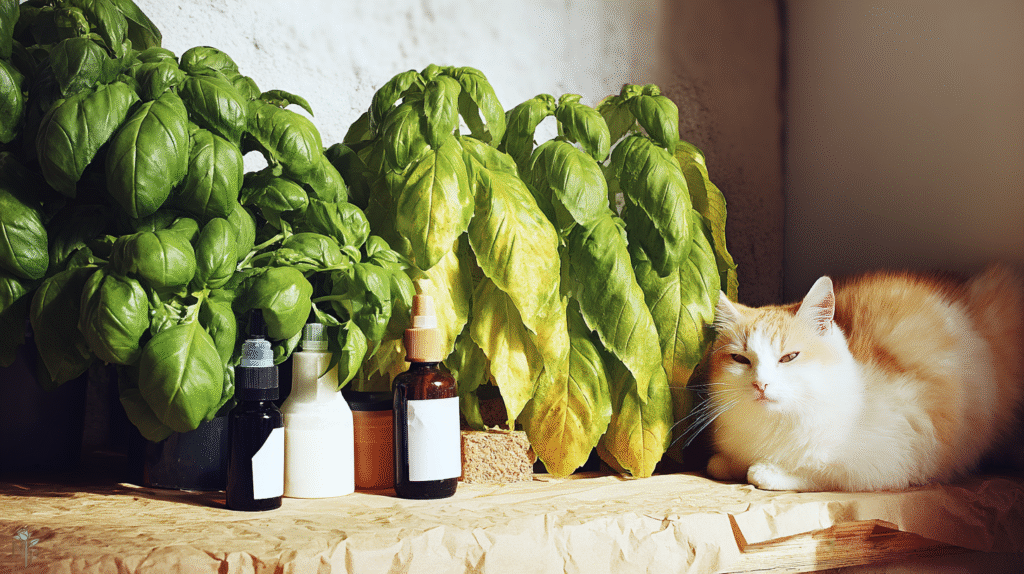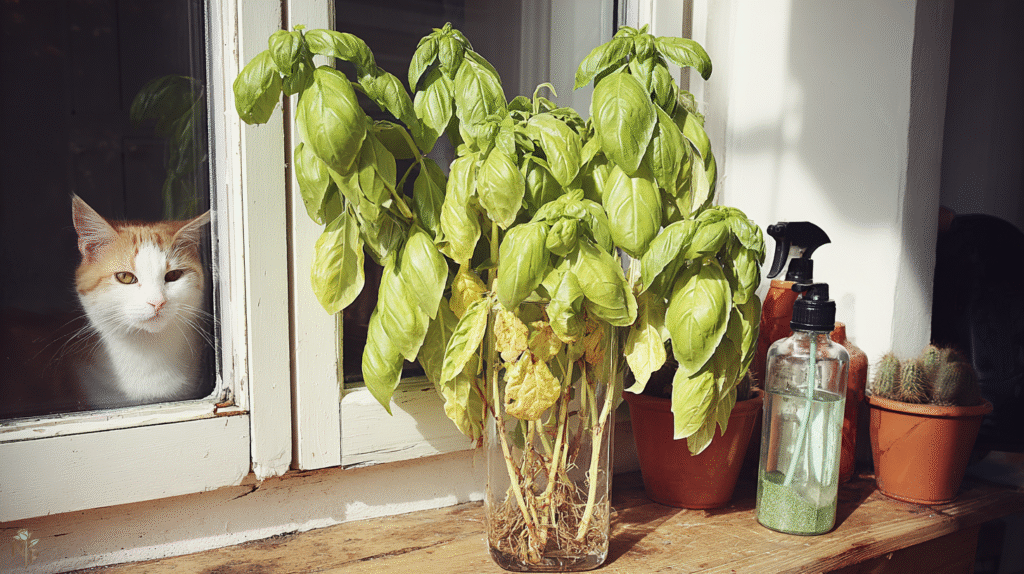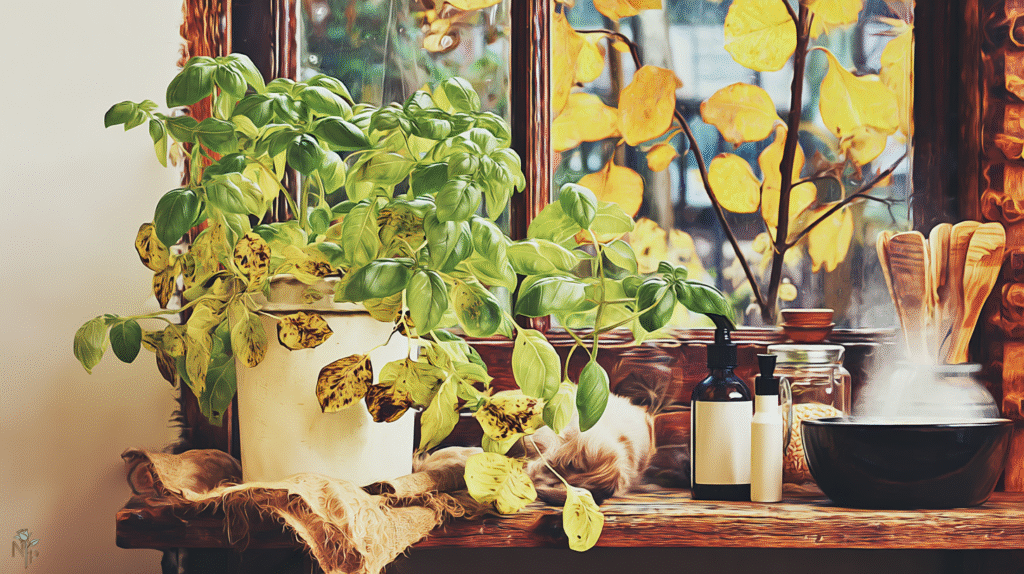My cat Herbert thinks every plant I bring home is his personal salad bar. Lost a peace lily that way (emergency vet visit, $400, he was fine). So when I started growing basil, first thing I googled was “will basil kill my cat.” Good news: basil is totally safe for pets. Bad news: Herbert now destroys my basil faster than any disease could.
But between Herbert’s attacks, I’ve dealt with every basil problem imaginable. Black spots, yellow leaves, stems that look like someone took a bite out of them (wasn’t Herbert that time), and this white fuzzy stuff that made my basil look like it was growing a beard.
Seven years and probably fifty basil plants later, I can diagnose a sick basil from across the room. Here’s every problem I’ve encountered, how to fix it, and most importantly, which solutions won’t poison your pets when they inevitably munch on your herbs.
First, The Pet Safety Thing (Because I’m Paranoid Now)
Basil itself is 100% safe for cats and dogs. They can eat it, roll in it, destroy it – worst thing that happens is maybe an upset stomach if they go really crazy. Herbert once ate an entire plant. Just had basil breath for a day.
But here’s what scared me: a lot of common treatments for basil problems are NOT pet-safe. Neem oil? Toxic to cats if ingested. Chemical fungicides? Hell no. Even some “organic” sprays can make pets sick.
So everything I’m about to tell you is stuff I’ve personally used with a cat who treats my garden like his personal buffet. If it wasn’t safe for Herbert, I didn’t use it.

The Yellow Leaf Situation
This is usually the first sign something’s wrong. But yellow leaves can mean like eight different things, which is super helpful.
Bottom leaves yellow, falling off: Normal. Basil drops old leaves to focus on new growth. Unless it’s happening fast (like multiple leaves daily), just pick them off and move on. Herbert likes playing with the fallen yellow ones.
All leaves turning pale yellow: Nitrogen deficiency. Your basil is hungry. I feed mine with diluted fish emulsion every two weeks. Yes, it smells like death. Yes, Herbert goes absolutely insane for it. But it’s pet-safe and works amazing. Just keep your cat away for an hour after application or you’ll have a very fishy-smelling pet.
Yellow between the veins (veins stay green): Iron deficiency. Usually happens when soil pH is off. I fixed this with used coffee grounds worked into the soil. Takes a few weeks but works. Plus Herbert hates the smell of coffee so he leaves those plants alone temporarily.
The Dreaded Black Spots
Lost three basil plants before figuring this out. Started as tiny black dots, spread like wildfire, killed everything.
Bacterial leaf spot: Most common culprit. Spreads through water splash. Once it starts, you can’t cure it, only control it. Remove affected leaves immediately (trash them, don’t compost). Water at soil level, never from above. Space plants so air circulates.
Pet-safe treatment that actually works: 1 tablespoon baking soda + 1/2 teaspoon dish soap (Dawn, not antibacterial) + 1 gallon water. Spray weekly. Herbert licked some once, made a face, never tried again.
Fungal spots (Cercospora): Similar looking but grayer, with yellow halos. Same treatment as bacterial but add improving air circulation. I had this in my crowded windowsill herbs. Moved them further apart, problem solved.
White Fuzzy Stuff (Two Different Nightmares)
Powdery mildew: Looks like someone dusted your basil with flour. Shows up when humidity is high but leaves are dry. My bathroom basil gets this every damn summer.
Fix: Milk spray. Not joking. 1 part milk to 9 parts water. Spray every few days. The proteins in milk act as antiseptic in sunlight. Herbert thinks I’ve lost my mind spraying milk on plants, but it works and won’t hurt him if he licks it.
White fuzzy mold on soil: Different problem. Usually from overwatering. Scrape it off, let soil dry out, add circulation. I put a tiny fan near my indoor herbs now. Mold gone, plus the moving leaves apparently entertain Herbert for hours.
Holes in Leaves (When It’s Not Your Cat)
Herbert puts clean bite marks in leaves. But sometimes I find different damage:
Tiny holes all over: Flea beetles. These jerks are fast. You’ll rarely see them. Basil usually survives but looks ugly. I dust with food-grade diatomaceous earth (pet-safe when dry, keep pets away during application). Works but needs reapplying after rain.
Large irregular holes: Slugs or caterpillars. Hand-pick at night with a flashlight. Gross but effective. Beer traps work for slugs but Herbert tried to drink from one once so I stopped that method.
Leaves stripped to veins: Japanese beetles. These metallic bastards will destroy basil overnight. I knock them into soapy water every morning. Time-consuming but pet-safe. Herbert enjoys watching me curse at beetles.

Wilting Drama
Basil wilts for everything. Too dry, too wet, too hot, too cold, looked at it wrong.
Wilting with dry soil: Needs water, obviously. But basil that’s repeatedly drought-stressed gets bitter. Keep soil consistently moist. I learned this after wondering why my neglected basil tasted like anger.
Wilting with wet soil: Root rot. Usually fatal. Caused by overwatering or bad drainage. If caught early, repot in fresh, dry soil and pray. I’ve saved exactly one plant this way out of maybe six attempts.
Sudden dramatic wilting: Fusarium wilt. Soil-borne disease. No cure. Plant goes from fine to dead in 48 hours. Remove entire plant and soil. Don’t plant basil there again. This killed my entire garden bed one year. Now I rotate where I plant basil.
Stem Problems
Brown/black at soil line: Stem rot from overwatering or water sitting on stems. Fatal if it circles the whole stem. Sometimes you can save it by cutting above the rot and rooting in water. Herbert drinks from the rooting glasses so I have to put them up high.
Woody stems: Not a disease, just old basil. Pinch flowers before they open to prevent this. Once woody, flavor decreases. I let Herbert have the woody stuff since he doesn’t care about culinary quality.
My Pet-Safe Treatment Arsenal
After years of trial and error with Herbert as my unwilling test subject, here’s what I keep on hand:
- Baking soda spray (fungal issues)
- Milk spray (powdery mildew)
- Dish soap spray (aphids, soft-bodied insects)
- Diatomaceous earth (flea beetles, ants)
- Fish emulsion (general fertilizer)
- Coffee grounds (pH adjustment, slug deterrent)
All of these are safe if pets investigate, though most smell bad enough that pets avoid them. Except fish emulsion. Herbert would bathe in that if I let him.
Prevention (Because Treatment Sucks)
Morning watering only: Wet leaves at night = fungal party. Learned this after killing five plants with evening watering.
Bottom watering for indoor plants: Prevents splash-spread diseases and keeps leaves dry. I use saucers under pots, fill those instead of watering from above.
Proper spacing: Air circulation prevents 90% of problems. My crowded basil always gets sick. Spaced basil rarely does.
Clean tools: Bacterial spot spread through my entire herb garden via pruning shears. Now I wipe with rubbing alcohol between plants.

When to Give Up
Sometimes basil is just doomed. If more than half the plant has issues, or if it has Fusarium wilt, or if it’s so stressed it tastes terrible – compost it and start over. Basil grows fast. Not worth nursing a sick plant for weeks.
I used to feel guilty throwing away struggling plants. Now I see it as making room for healthy ones. Plus, Herbert prefers young, tender basil anyway. The old struggling plants are tough and apparently less delicious.
The Bottom Line
Most basil problems come from water issues – too much, too little, or on the leaves instead of soil. Fix your watering, fix 80% of problems. The other 20% can mostly be handled with baking soda, milk, or telling Herbert to stop treating the garden like his personal playground.
The best part about basil being pet-safe? When Herbert inevitably destroys a plant, I don’t panic. Just mild annoyance and maybe some creative cursing. Way better than another emergency vet visit.






